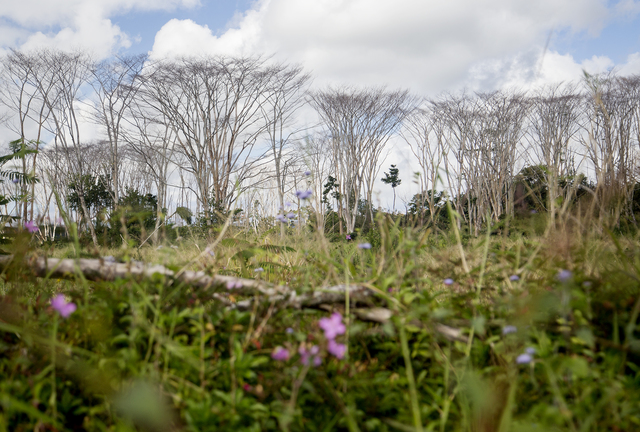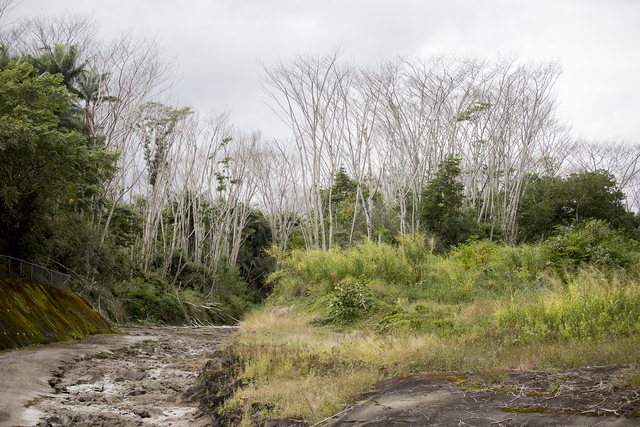The tree that ate Puna may soon have to go on a diet.
The tree that ate Puna may soon have to go on a diet.
Eighteen months after thousands of albizia trees toppled by Tropical Storm Iselle damaged homes, blocked roadways and knocked out power in lower Puna, multiple bills up for discussion by legislators this session appear poised to tackle the troublesome invasive species.
Among the fastest-growing trees in the world, and far taller than native trees, albizia have rapidly taken over large swaths of forests across the island, hogging the sunlight and crowding out important native species such as the ohia.
They also have earned widespread notoriety for the weakness of their wood, leading to heavy branches snapping off and even whole trees toppling over in moderate to heavy winds. Hawaii Electric Light Co. crews have identified the trees as their No. 1 enemy because of their propensity for knocking down power lines when they fall.
But it was Tropical Storm Iselle that thrust the dangers of albizia trees to the forefront. As the storm approached and made landfall on the Big Island, heavy winds played havoc with the brittle trees, destroying and damaging homes and vehicles, trapping residents in their neighborhoods by blocking roadways, and knocking out power for weeks in some locations.
All told, damage and debris expenses totaled about $13.2 million, former Gov. Neil Abercrombie wrote in a letter to President Barack Obama seeking federal disaster relief funding.
Fortunately, says U.S. Forest Service ecologist Flint Hughes, recent studies have shown that the spread of the trees can be controlled, and for a smaller investment of time and money than many previously worried.
Pilot projects have shown that treating albizia trees with the herbicide Milestone is a cost-effective way of clearing them from high-priority areas, like near roadways and power lines, as well as residential areas. As the trees die, they dry up and lose water mass, making them much lighter and less likely to do damage should they fall. Within a few years, they tend to crumble away, he said.
“What we are learning from our current research is that these control actions with albizia will work. Either by cutting and herbiciding all of it or some of it, and killing nonhazard trees when you can. If and when you’re able to do that, the techniques employed now are effective — not only in killing them, but in maintaining those areas as albizia free,” Hughes said.
By treating only albizias in a given area, surrounding native trees can benefit from the increased sunlight once the albizias drop their leaves, moving to close in openings in the canopy and preventing sun-loving albizia seedlings from finding a strong purchase in the soil, he said.
“The research is showing that it can very much be a one-and-done kind of approach,” Hughes said. “If you put the effort into getting rid of those big trees, you set yourself up to have a low-maintenance scenario down the road.”
To that end, Senate Bill 2750, introduced by state Sen. Russell Ruderman, D-Puna, and its companion, House Bill 2516, introduced by state Rep. Nicole Lowen, D-Kailua-Kona, seek $5 million for the Department of Land and Natural Resources and the Big Island Invasive Species Committee to follow through with a coordinated management program for the invasive trees.
The money, which would fund the program for fiscal year 2016-17, would only be used for control measures on Hawaii Island. It would include the complete removal of albizia from highway rights of way, while trees outside the right of way that are deemed nonhazardous would be treated with Milestone and left in place.
Targeted areas would include the two-mile stretch of Pahoa-Kapoho Road between Lava Tree State Park and Pahoa; isolated patches of albizia trees between Kalapana and Pahoa; isolated patches of albizia trees between Pahoa and Keaau; the hospital corridor, particularly the segment of Waianuenue Avenue from Komohana Street to Akolea Road; the segment of Akolea Road from Waianuenue Avenue to Kaumana Drive; Puainako Street from Highway 11 to Kaumana Drive; and any additional areas of the island as deemed necessary by the Big Island Invasive Species Committee.
“The pre-planned removal of each albizia tree costs significantly less than the combined direct and indirect costs of removal if and when it falls into a road, power line or building,” the bill reads. The Big Island Invasive Species Committee has demonstrated the effectiveness and necessity of a coordinated approach to controlling the growth and spread of albizia trees.”
Ruderman, who has long championed efforts to control albizia, said Thursday that he is expecting a difficult slog to get his bill through the Legislature.
“I think, unfortunately, that the DLNR is being especially squeezed right now as a matter of change in policy, and I think that is absolutely wrong,” he said. “There is this anti-environmental attitude among the people running things right now. It’s not only wrong, but foolhardy.”
He added that while Puna has so far been impacted the most by the spread of albizia, including the devastation caused by Iselle, it’s a problem that can affect virtually any neighborhood in the state.
“If we don’t control it, we are doomed to repeat this tragedy innumerable times,” he said.
On Jan. 27, SB 2750 was introduced, passed its first reading and was referred to three different Senate committees. The bill has yet to be scheduled for a hearing in those committees.
The companion bill, HB 2516, was introduced and passed its first reading Jan. 27 and was referred to the House committees on finance, and water and land Feb. 1. No hearings have yet been scheduled.
Email Colin M. Stewart at cstewart@hawaiitribune -herald.com.





